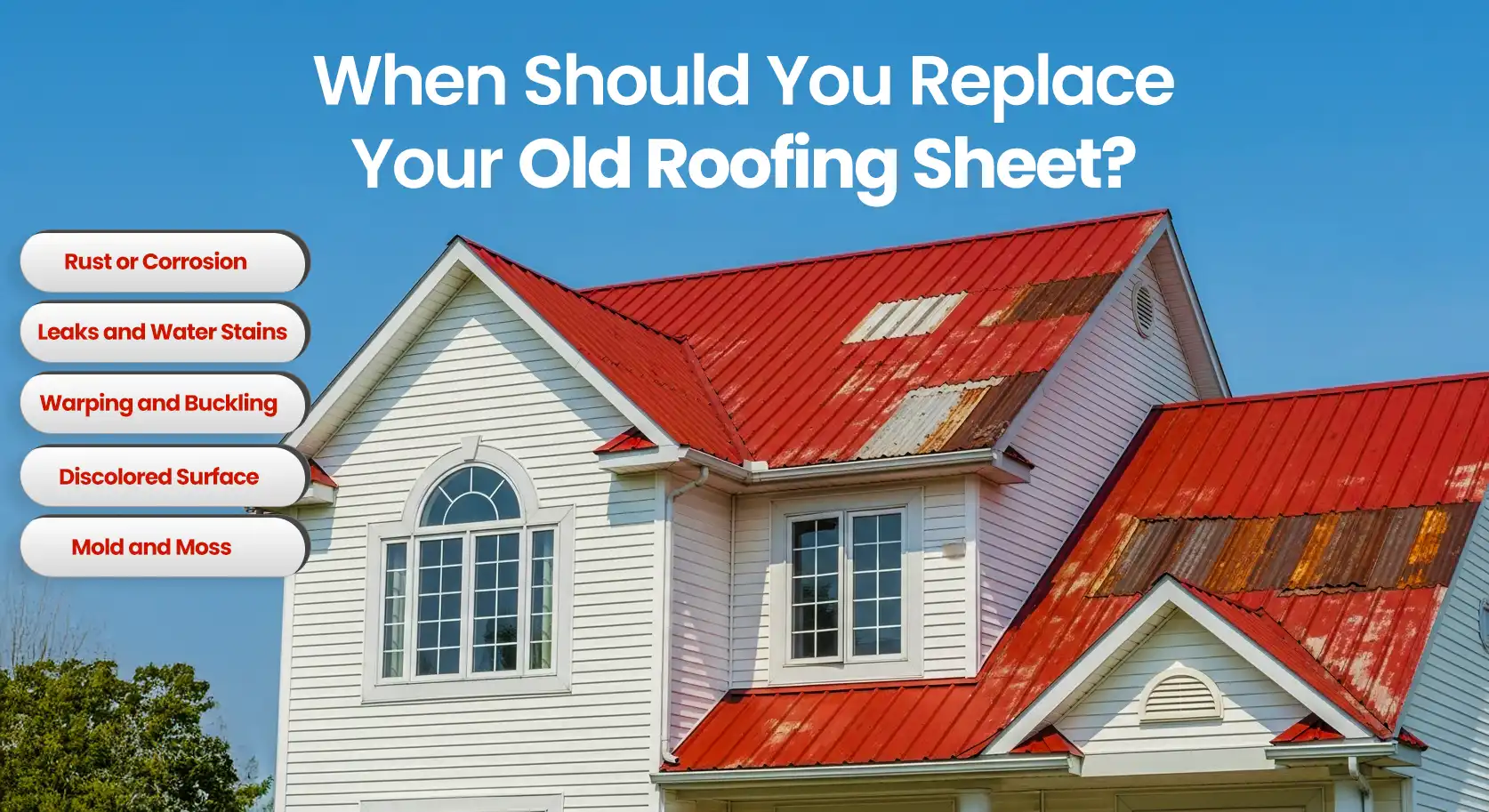
Introduction
Your roof is your home’s first line of defense against the elements-but roofing sheets don’t last forever. Over time, weather, rust, and structural wear can compromise their integrity, leading to leaks, energy loss, and even costly structural damage. Knowing when to replace your old roofing sheet can save you thousands and protect your investment. In this guide, we’ll cover every sign, timeline, and expert tip you need to make an informed decision-whether you’re dealing with metal, asphalt, polycarbonate, or fiber cement sheets.
Signs to Replace Roofing Sheet:
Not all roof problems require a full replacement-but certain signs should never be ignored. Whether you’re using metal, asphalt, or polycarbonate sheets, these red flags signal it’s time to consider a new roof:
-
Visible Rust or Corrosion
Metal roofing sheets, especially galvanized steel, will eventually rust or corrode due to prolonged moisture exposure. Surface rust can be treated, but widespread corrosion means replacement is safer and more cost-effective.
-
Leaks, Water Stains, or Dripping
Persistent leaks or brown stains on your ceilings or walls suggest your roofing sheet has failed to keep out moisture. If repairs keep recurring, it’s time for a full replacement.
-
Loose or Missing Fasteners and Screws
When fasteners start to lift or go missing, the integrity of the sheet is compromised. This can lead to wind uplift, leaks, and further damage during storms.
-
Warping, Buckling, or Sagging
Roofing sheets that appear uneven, sagged, or visibly warped may have moisture trapped beneath or have suffered structural damage-especially on older roofs.
-
Faded or Discolored Surface
UV exposure and weathering can cause color loss or chalking on metal and polycarbonate sheets. While not always a structural issue, this often indicates aging and material fatigue.
-
Mold, Moss, or Algae Growth
The presence of biological growth suggests prolonged moisture retention. This can degrade roofing materials, affect indoor air quality, and signal insufficient ventilation or drainage.
“Always inspect your roof after extreme weather like hail, high winds, or heavy rainfall. Even if the damage isn’t visible from the ground, a professional inspection can catch early signs before they become expensive repairs.”
Repair vs Replacement: Which One is Better?
Not every roofing problem means you need to tear off and replace the entire roof. Sometimes, a targeted repair is all it takes-other times, it’s a temporary patch on a much bigger issue. Here’s how to know which path to take.
| Factor | Repair | Replacement |
|---|---|---|
| Cost | Lower upfront | Higher but long-term value |
| Damage Extent | Minor issues | Extensive wear or leaks |
| Age of Roof | Under 10-15 years | Over 15-20 years |
| Warranty | May not be extended | New warranty coverage |
When Repair Makes Sense:
- Isolated damage after a storm (e.g., a few sheets blown off)
- Newer roof under manufacturer warranty
- No signs of moisture intrusion inside the house
- Budget constraints but need immediate fix
When Replacement is the Better Option:
- Roof has exceeded 75–80% of its expected lifespan
- Frequent leaks or ongoing patchwork repairs
- Visible sagging, widespread corrosion, or fastener failure
- Want to upgrade for energy efficiency or resale value
“If repair costs exceed 30% of the replacement cost, go for a new roof. It’s a smarter investment.”
– Certified Home Inspector, InterNACHI
Risks of Delaying Roof Sheet Replacement
Ignoring roof problems can have serious consequences for your home’s safety and finances. According to the National Roofing Contractors Association (NRCA), a roof is not just a cover; it is your home’s first and most critical barrier against harsh weather, water intrusion, and structural damage. Small issues like minor leaks or damaged flashing often escalate quickly into major water damage that causes rust on metal components, weakened roof framing, mold growth, and costly structural repairs if left unattended. Homeowners who delay roof maintenance risk premature roof failure, higher repair costs, reduced energy efficiency, and even potential liability from unsafe conditions. Preventive roof care guided by industry best practices—such as biannual inspections by certified professionals using tools like thermal imaging and drones—can extend the roof’s lifespan by up to 15 years and cut emergency repair costs by nearly 50% (source). Investing in timely roof repairs not only protects your home’s structural integrity but also maintains property value and provides peace of mind against increasingly extreme weather events. Prioritizing roof maintenance is thus an essential strategy backed by rigorous industry data and expert consensus to avoid the hidden, escalating costs of neglect.
Key Disadvantages of Ignoring Roof Replacement or Repairing:
- Minor leaks and damages can quickly escalate to extensive water infiltration, causing mold, rust, and structural weakening.
- Delayed repairs increase the likelihood of premature roof failure, which can cost 40-60% more than routine maintenance.
- Neglected roofs reduce energy efficiency by allowing heat loss or moisture buildup, leading to higher utility bills.
- Structural damage from water intrusion can compromise the entire building framework, leading to costly safety hazards and legal liabilities.
- Ignoring maintenance voids warranties and complicates insurance claims related to roof damage.
- Timely professional inspections using advanced technology like thermal imaging and drones help detect issues early, minimizing expensive emergency repairs.
- Extended roof lifespan through regular upkeep can save homeowners thousands over decades by avoiding premature replacement.
Roofing Sheet Lifespan by Material Type
One of the most common questions homeowners ask is, “How long should my roofing sheet last?” The answer depends largely on the material, environmental exposure, and maintenance. Here’s a breakdown of average lifespans and key signs it’s time to replace.
| Material Type | Average Lifespan | Replacement Indicator |
|---|---|---|
| Al-Zn Coated Roofing Sheet | 20–30 years | Corrosion, rust, loss of finish |
| Aluminum Sheets | 30–45 years | Dents, oxidation |
| Zinc Roofing | 40–70 years | Fading, cracks |
| Asphalt Shingles | 15–25 years | Curling, granule loss |
| Polycarbonate Sheet | 10–20 years | Yellowing, brittleness |
| Fiber Cement | 25–40 years | Cracks, water absorption |
“Roof lifespan is not just about age-it’s about condition. Even a 10-year-old roof may need replacement if it’s been poorly maintained or weather-damaged.”
– Certified Roofing Specialist, NRCA Member
Conclusion
If you properly care for your roofs, they are an investment in the safety, comfort and value of your home. Which comes with regular cleaning, inspections and repairs before damage occurs will not only prevent expensive damage, but on the other increase the life of your roofing sheets, and provide a long period of protection from the harsh weather. Look for professionals for inspections.
Some Sources of Real-World Users
- How to know when my roof needs to be replaced – Quora
- When to replace exposed-fastener metal roof – Reddit
Written and Verified by:

Rhino Roofs
Bio: Leading roofing sheet manufacturer with 50+ years of experience in the Northeast. Rhino Roofs provides color-coated, galvalume and asbestos cement roofing sheets.
FREQUENTLY ASK QUESTIONS
To extend roofing sheet life and prevent leaks, clean debris regularly, inspect for rust or cracks, tighten loose fasteners, seal overlaps properly, and apply protective coatings. Ensure proper slope and ventilation. Hire certified roofers for yearly checks. Follow manufacturer care guidelines for best results.
Roofing sheet life is affected by sun exposure (UV damage), rain, humidity (causes rust and mold), wind (loosens fasteners), salt air near coasts (corrosion), snow and ice (weight and freeze-thaw damage), and pollution (chemical wear). Local climate and weather extremes play a major role in how long your roof lasts.
Yes, you can replace part of the roofing sheet if the damage is limited to a small area. It’s a cost-effective solution for minor issues like leaks, cracks, or rust. However, color or material matching can be tricky, and if the roof is old or damage is widespread, full replacement is usually better for long-term protection.
Roofing sheet replacement usually takes 1 to 3 days, depending on roof size, material type, weather, and crew size. Simple repairs may take a few hours, while larger or more complex roofs may need extra time. Always allow for delays if weather is bad or structural issues are found during the process.
Choose roofing sheet material based on your local climate, budget, roof slope, and design preference. Metal suits all-weather, polycarbonate is light and UV-resistant, and asphalt is budget-friendly. Check lifespan, insulation, and maintenance needs. Always follow expert advice and product warranties for best results.
To check your roofing sheet, look for rust, cracks, leaks, loose screws, or sagging. Inspect after storms and twice a year. Use binoculars or a drone for safety. Check from inside for water stains or mold. For thorough inspection, hire a certified roofer to assess hidden or structural issues.

